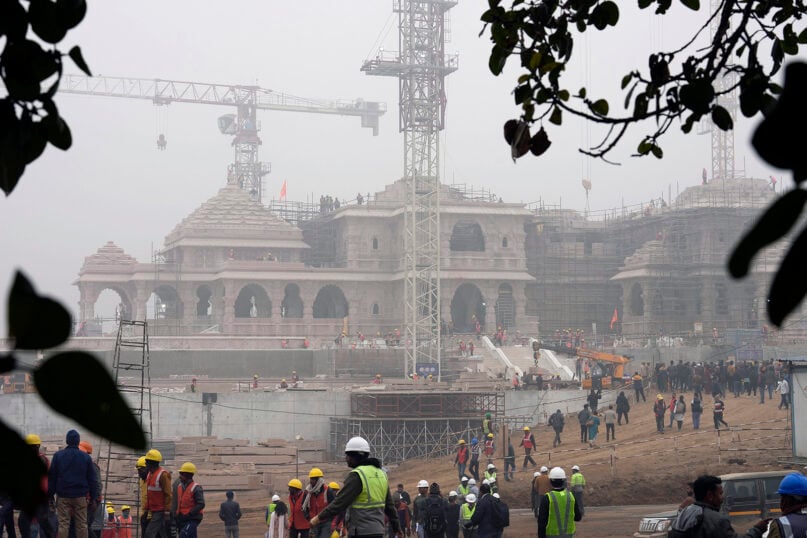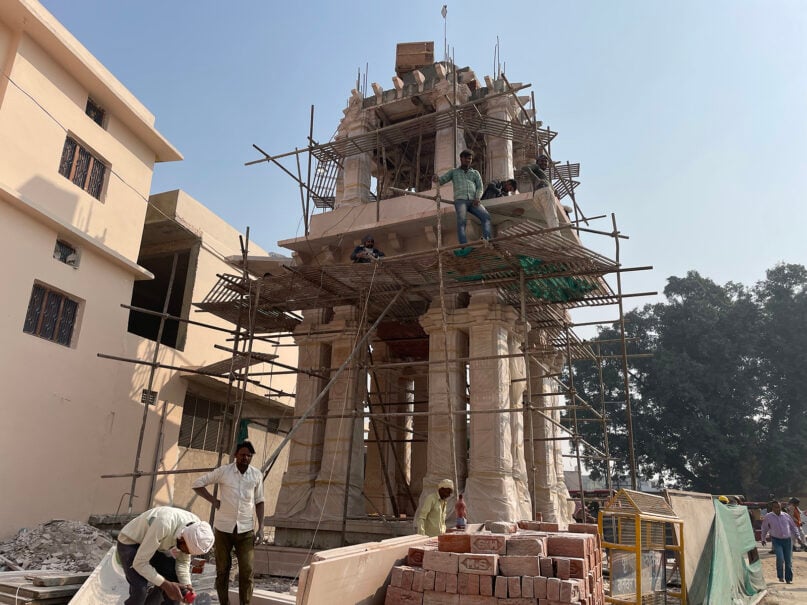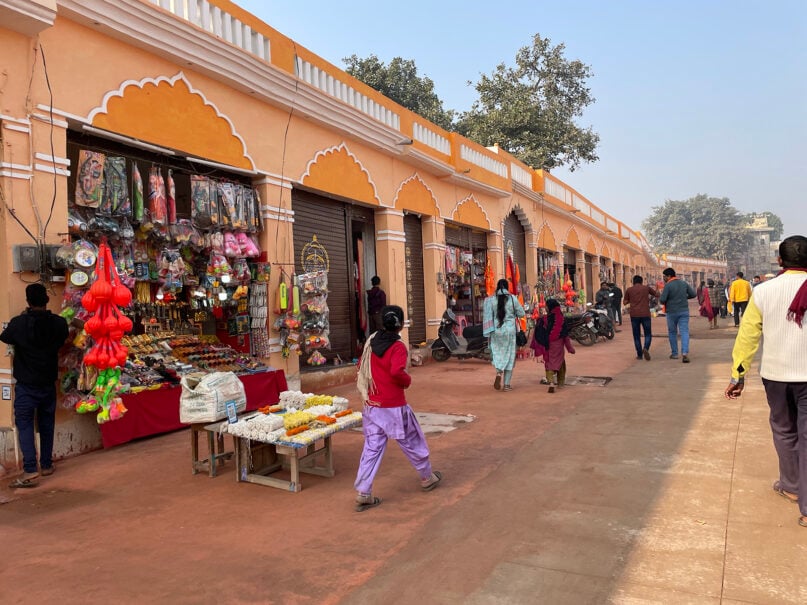AYODHYA, India (RNS) — Once a quaint, if historically and religiously significant, village, this 2,500-year-old city in northern India has been transformed into a global pilgrimage site befitting the birthplace of the Hindu god Ram.
Cobbled streets are being widened to hold tourist buses and VIP vehicles. Storefronts are uniformly being painted with the saffron emblem of Lord Ram. At worksites blaring Hindu-nationalist-themed pop music, laborers from across the country are building throughout the night. At the center of the face-lift is a long-anticipated temple honoring Ram, one of Hinduism’s most treasured deities, said in the Sanskrit epic the Ramayama to have been born here.
“This is a gift for Hindus of this nation and all around the world,” said Manmeet Gupta, a local TV news reporter. “Because after 500 years of struggle, they can finally see Ram lalla (infant) installed in his rightful birthplace.”
But the new temple, which will be the third-largest Hindu place of worship in the world, is a triumph too for the Hindu nationalist movement that in many ways was born in Ayodhya 30 years ago, when a Hindu mob tore down a mosque that occupied the site.
Hindutva, a Hindu-Sanskrit compound that translates to Hindu-ness, has existed for a century, but tensions in Ayodhya began in the 1980s, when Hindus belonging to Vishwa Hindu Parishad, which the CIA identified as a “religious militant organization,” began a campaign to replace the Babri Masjid, or Babri mosque, with a temple to Ram. Pointing to a finding by the government’s Indian Archaeological Survey that remnants of a “non-Islamic structure” and objects with ancient Hindu imagery were discernible beneath the mosque, the group argued that the land rightfully belonged to the god.
Rallies calling for a temple on the site were organized by the Hindu nationalist Bharatiya Janata Party, contributing to its rising political power, which in turn emboldened Hindus with a strong nationalist tilt and a distaste for Muslim imperialism. It was a BJP rally in December 1992 that turned violent and resulted in the destruction of the masjid. The demolition sparked riots across India, Pakistan and Bangladesh, where more than 2,000 were killed in retaliatory violence.
Murari Kumar Pandey, a Hindu who grew up “500 meters from Ram’s birthplace,” recalls playing in Shaheed Galli, or Martyr’s Alley, where dozens of Hindu volunteers, known as kar sevaks, died at the hands of police. “Our parents and grandparents couldn’t see it. All they saw was the Babri Masjid.”
Apart from the riots, the mosque’s destruction spawned a legal case that raged on through all levels of the Indian justice system for two decades, ending only in 2019. At one point the infant Ram made an appearance as a litigant. Construction on the temple began in 2020, when the land was blessed with water from India’s sacred rivers. Since then, Hindus from Ayodhya’s Uttar Pradesh and neighboring states have come to work on the temple to be part of history.
In the meantime, in 2014, the BJP, running on the promise of restoring the temple site, took power in Congress, led by now Prime Minister Narendra Modi.
Modi and BJP have a comfortable lead in elections that will be held this spring, thanks to Hindus such as Pandey, who takes great pride in the new temple and credits Modi and Yogi Adityanath, a Hindu monk and chief minister of Uttar Pradesh, for making it happen.
Many local residents, such as Chandramal Mishra, a 38-year-old supervisor on the project, have come to work on the temple and other new buildings. Some had never worked in construction before. A native of a village less than 10 miles from Ayodhya, he had juggled several jobs before landing a role as the head of an electrical team at the temple site. For the last eight months, he has slept in a makeshift dorm with 500 beds and 35 bathrooms. “There are times when I’m needed even at 2 a.m. for work on site,” he said.
Far from complaining, Mishra said that the camaraderie among the volunteers is enough to sustain him. “I’m a Brahmin” — considered the highest of India’s social castes — “but no one asks me why I am working on a construction site. To use a shovel on the land of Ram Mandir is a matter of pride for me.”
Many workers, such as Sapna Sahu, tirelessly polish blocks of intricate marble with sandpaper, chanting “Jai Shri Ram” as they work, which they consider seva, or service, to their beloved Lord. Though each block takes two weeks to polish, she said, “I haven’t counted the stones I polished so far in two years.”
In the past year, luxury hotels, an international airport and major clothing brands have established outposts in Ayodhya, offering not only employment opportunities but shiny attractions for outsiders. But as part of the massive revamp to host millions of expected tourists, some residents have been dispossessed of their homes and land and claim that they were compensated poorly. These residents are now questioning the price of the Ram temple.

Sahu’s friend and fellow stone polisher Snehlata watched as her in-laws’ house was demolished by district authorities. “Ayodhya is our home,” said the 28-year-old. “That’s why we are sad. It is a very sad feeling to lose our home. But if they are well compensated for this, then it is better for all.”
An economic boom, it is hoped, will erase Ayodhya’s political notoriety. The inauguration of the temple “is the day we all have waited for,” Snehlata said. “Until the Mandir exists, this stone will be etched in there. … Our kids will remember that I worked on this.
“A person can earn a living anywhere, but this is beyond belief. An opportunity of a lifetime.”
The area’s Muslims are taking less satisfaction from the city’s growth. In 2019, the Indian government, having awarded the disputed site to the temple, allocated 5 acres in a nearby village for a new mosque, barely 150 meters from the highway to the state’s capital, Lucknow. The trust responsible for the mosque construction, the Indo-Islamic Cultural Foundation, still awaits funds, an official said.
Mohsin Khan, who grew up near the mosque site, was elated to hear that a “grand mosque” would be built in his neighborhood. “But it has been a long time since then and there has been no work,” he said. “It is saddening and cruel.”
As the sun went down and children finished their prayers at the existing mosque and ran toward the open field where the Ayodhya Mosque is to be built, local women looked after their grazing buffaloes in the field. “Children play here. Sometimes we even join them for a bit. That’s all that happens here,” said Khan. “What’s the point of keeping looking at this land otherwise?”
With little time left until the inauguration date for the temple, roads remain unpaved, stones remain uncarved and the temple is still unfinished. The murti, or idol, of Ram Lalla will be consecrated on Jan. 22, but Mishra suggested that the temple complex will not be fully ready until 2028.
The rush to meet deadlines has triggered political divisions, with opposition leaders declining an invitation to the ceremony. “The inauguration of the incomplete temple by the leaders of the BJP and the RSS has been obviously brought forward for electoral gain,” the Congress Party said in a statement on Jan. 10, referring to both their political opponents and the RSS, the religious and social organization that fostered the BJP.

Still, tourists are already beginning to arrive, some sneaking construction debris into their pockets to bring home. Others stack rocks to make little “homes” in a spiritual tradition similar to tossing coins in a wishing well.
Nitish Yadav, a 30-year-old pilgrim from central India, traveled with his family for 48 hours to reach Ayodhya. “No one can stop it now,” he said regarding the construction site, as tears welled in his eyes. “Ram has returned home.”
“We have also made a home for Ram lalla on this land,” added Yadav’s wife, Rajni, as she watched her son stack up rocks near the fence. “We couldn’t wait till the opening to see this.”
Yadav has an added sense of pride from having a hand in the event. “After waiting for 500 years, a Hindu of Modi’s stature has come to realize this dream,” he said. “I voted for the BJP in 2014 so that this day can come.”

